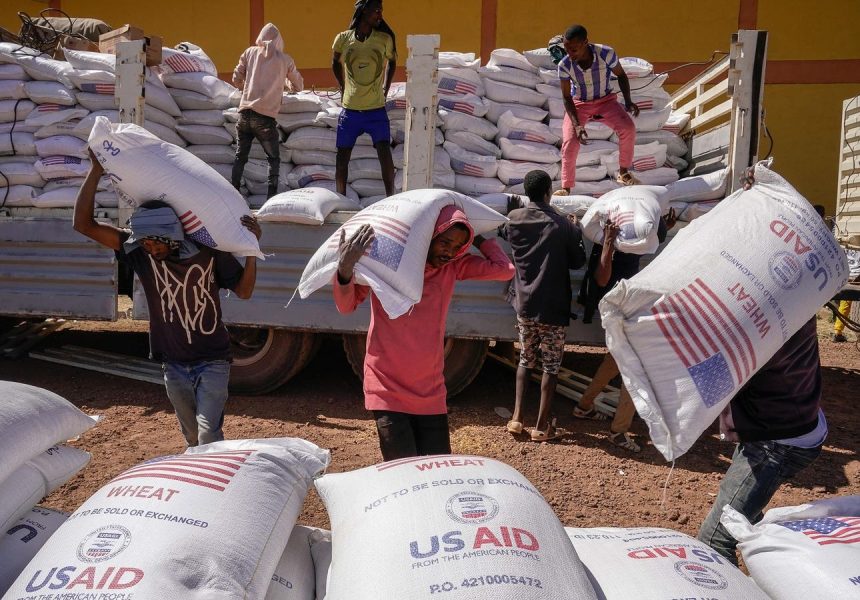President Trump’s abrupt 90-day freeze on foreign aid, coupled with the potential dismantling of the United States Agency for International Development (USAID), has sent shockwaves through the global development and humanitarian aid landscape. Trump’s declared objective of slashing $2 trillion from government spending, with foreign aid earmarked for significant reductions, has raised concerns about the future of American leadership in international development and the devastating impact on vulnerable populations worldwide. The sudden suspension of USAID activities, with employees barred from their offices and the agency’s website offline, signals a dramatic shift in U.S. foreign policy priorities under the new Trump administration. Elon Musk’s involvement in the Department of Government Efficiency, tasked with identifying areas for budget cuts, adds another layer of uncertainty to USAID’s fate. While Secretary of State Marco Rubio has assumed the role of acting USAID director, promising to evaluate the agency’s spending based on its contribution to U.S. security and prosperity, the criteria remain ambiguous, leaving the agency’s future hanging in the balance.
USAID, established under President Kennedy, has served as the primary instrument for distributing U.S. foreign aid, encompassing a wide range of activities from food and water provision in conflict zones to maternal and child health initiatives, disease prevention programs, and disaster relief. With a budget exceeding $44 billion in fiscal year 2024, representing a mere 0.4% of the federal budget, USAID plays an outsized role in addressing critical global challenges. The agency’s extensive reach, employing approximately 10,000 individuals, two-thirds of whom work overseas, primarily in Asia, sub-Saharan Africa, and Europe (including Ukraine), highlights its significant global presence. The potential consequences of a drastically reduced or eliminated USAID are profound, given the United States’ position as the world’s leading donor of international aid, contributing $68 billion in 2023, with USAID accounting for over half of that amount.
The ramifications of a weakened USAID extend far beyond the agency itself, impacting a network of vital global health initiatives reliant on its support. The President’s Emergency Plan for AIDS Relief (PEPFAR), launched by President George W. Bush, stands as the largest national commitment to combating a single disease in history. Trump’s executive order temporarily halting PEPFAR activities, although partially mitigated by a subsequent waiver allowing for the distribution of some HIV medications, casts doubt on the future of this crucial program, especially concerning preventative measures. Similarly, the President’s Malaria Initiative, another Bush-era program that established the U.S. as the primary funder of anti-malaria efforts, faces significant setbacks, with reports of two-thirds of its staff being dismissed.
The ripple effect of these cuts also extends to the fight against neglected tropical diseases (NTDs), often overlooked yet debilitating conditions affecting millions in tropical regions. These diseases, encompassing leishmaniasis, river blindness, Dengue fever, and trachoma, cause significant suffering, leading to blindness, chronic pain, and other severe health issues. Historically underfunded in terms of drug development and treatment distribution, NTD programs have relied heavily on U.S. aid agencies like USAID to fill the gap. The potential withdrawal of U.S. support could severely hinder progress against these diseases and exacerbate the health challenges faced by vulnerable populations.
The combined effect of these policy changes presents a grim outlook for international development and global health. The proposed merger of USAID with the State Department, while presented as a streamlining measure, is likely to result in substantial budget cuts and workforce reductions, diminishing the agency’s capacity to deliver crucial aid. This potential restructuring raises concerns about the effectiveness and independence of future U.S. aid efforts. The loss of experienced personnel and the redirection of funding away from critical health programs could undermine decades of progress in fighting infectious diseases and improving global health outcomes. Moreover, the uncertainty surrounding the duration and scope of these changes makes it difficult for partner organizations and recipient countries to plan for the future, potentially disrupting essential services and jeopardizing the health and well-being of millions worldwide.
The Trump administration’s approach to foreign aid represents a significant departure from previous U.S. foreign policy, prioritizing domestic spending and questioning the value of international assistance. The stated objective of ensuring that aid expenditures directly benefit U.S. interests raises concerns about the future of humanitarian aid, which by its nature is focused on alleviating suffering and promoting global well-being, not necessarily advancing specific U.S. national security or economic goals. This shift in focus could have far-reaching consequences, potentially undermining U.S. soft power and its standing in the international community, while simultaneously exacerbating global health disparities and jeopardizing progress toward achieving sustainable development goals. The long-term implications of these policy changes warrant careful consideration, as they could reshape the landscape of international development and humanitarian assistance for years to come.



